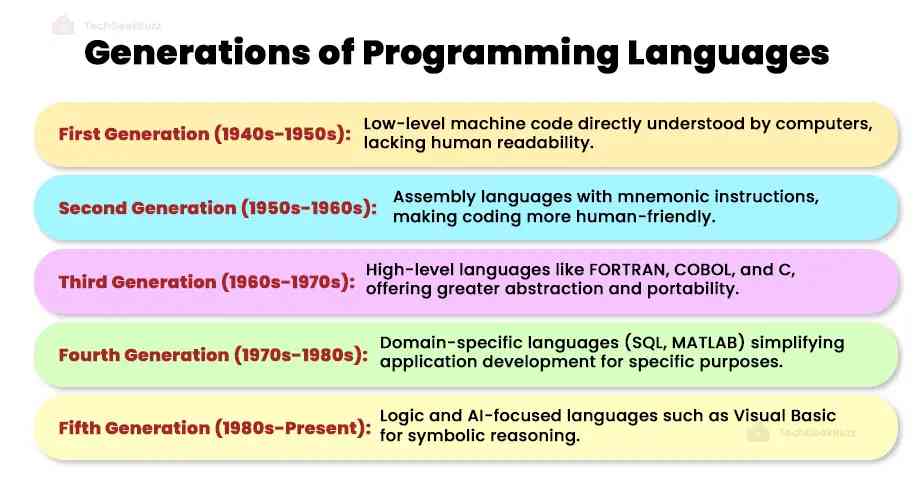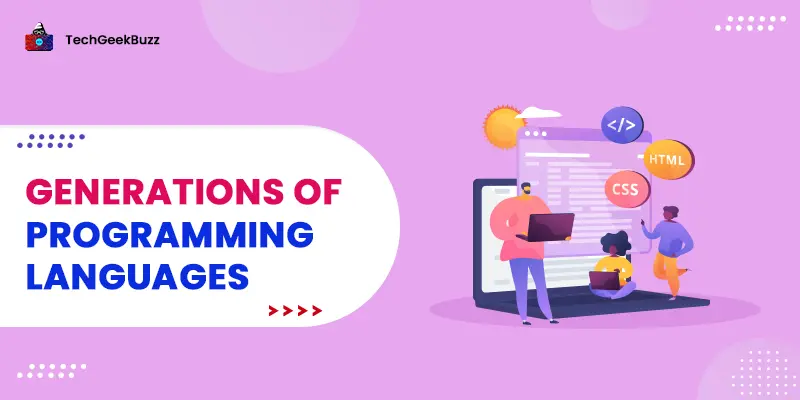As computers have generations, so do programming languages. These generations of programming languages indicate their increasing power and improved capabilities. They have evolved from simple machine languages that create basic applications to complex, feature-rich languages useful in developing smart and intelligent systems, apps, and tools.
There are five generations of programming languages – 1 GL, 2 GL, 3 GL, 4 GL, and 5 GL. This article aims to enlighten you about these generations.
So, let us get started!

5 Generations of Programming Languages: Evolution of Programming Languages
Let us understand each generation of programming languages in detail below.
1. First Generation Language (1 GL)
First-generation languages, or 1 GL, are low-level or machine languages. They are composed of 0s and 1s (binary bits) that only computers can read and interpret. A CPU can directly execute instructions in the machine language. As a result, first-generation languages do not require any language translator, like a compiler or assembler.
More interestingly, instructions written in a first-generation language are fed to computer systems through their front panel switches.
Pros
- The code runs faster and more efficiently on computer systems, as it is directly executed by the CPU and written in a binary language (0s and 1s).
- Low-level languages do not require any translator.
Cons
- It is pretty difficult to learn and master low-level languages, as they solely include 0s and 1s.
- Code written in low-level languages is challenging to edit if any errors are encountered.
- Dealing with the front panel switches of computers is intimidating.
- If new instructions are added to memory, it requires shifting existing instructions below the new insertion point.
- First-generation languages are machine-dependent and not portable. The code written for one specific system does not work on other systems. To work on another specific system, it needs rewriting.
2. Second Generation Language (2 GL)
Second-generation languages, or 2GL, are also low-level languages but consist of assembly languages. An assembly language is a low-level language to communicate directly with computer hardware. Unlike machine languages, assembly languages are readable by humans.
However, to run the assembly language code, it needs to be converted into machine code using an assembler.
Assembler - A language processor to convert assembly language instructions into machine code.
Kernels and device drivers sometimes use assembly languages. However, these languages are primarily used in intensive processing, such as games, video editing, and graphic rendering.
Pros
- Compared to machine language, an assembly language is easier to understand by humans.
- The code written in an assembly language is easier to edit.
- You can easily locate errors and fix them.
Cons
- Second-generation languages are specific processor families and environments.
- They require an assembler.
- They are machine-dependent, i.e., you need to write different instruction sets for different machines.
3. Third Generation Language (3 GL)
Third-generation languages, or 3GL, are high-level languages, such as C, C++, Java, COBOL, FORTRAN, PASCAL, etc. They are also referred to as procedural languages . These languages include English-like keywords that humans can easily understand and write instructions.
The code written in high-level languages needs to be converted into machine code using a compiler or interpreter .
Most third-generation languages support structured programming , while some support object-oriented programming . They are more abstract than previous-generation languages.
Pros
- Third-generation languages are more portable or machine-independent. You can use the same code to run on different machines.
- They are programmer-friendly.
- They leverage English-like syntax and are more human-readable.
- Writing the code for a specific task required fewer lines than in previous-generation languages.
Cons
- A compiler or interpreter is needed to convert a high-level language into machine language.
- Each programming language has a different compiler. So, programmers need to use a compiler accordingly.
4. Fourth Generation Language (4 GL)
Fourth-generation languages, or 4GL, are non-procedural programming languages specialized towards more specific programming domains. These languages support databases, mathematical optimization, report generation, GUI development, and webd development.
4GL improved the software development process with its block-structured mode and natural language. It significantly reduced the efforts and costs required in software development.
In addition, they exhibit higher abstraction than 3GL. SQL, PL/SQL, Oracle Reports, Unix Shell, ABAP, and R are common examples of fourth-generation languages.
Pros
- Fourth-generation languages are easy to understand and use.
- They significantly reduce software development effort and time compared to previous-generation languages.
Cons
- The 4GL code consumes more memory space.
- It has less control over hardware.
5. Fifth Generation of Language (5GL)
The latest generation of programming languages is the first generation, or 5GL. 5GL contains visual tools to develop software. The best example of 5GL is Visual Basic.
In other words, the fifth-generation language is any programming language centered around problem-solving based on the given constraints. It does not leverage an algorithm(s) provided by a programmer.
Some examples of fifth-generation languages include constraint-based, declarative, and logic programming languages. They utilize artificial intelligence to equip computer systems with features to solve problems on their own rather than a programmer.
OPS5 and Mercury are popular examples of fifth-generation of programming languages.
Pros
- Computer systems can solve problems on their own using 5GL.
- This reduced programmers’ efforts.
- 5GL is easier to learn and understand.
Cons
- 5GL involves complex and lengthy code.
- They require more resources, which can be expensive.
Conclusion
This was all about the generations of programming languages. Each generation of programming languages evolved into better ones than its predecessors, bringing significant improvements and advancements. Throughout the five generations, programming languages have become more robust, expressive, and versatile, reducing programmers’ efforts and development costs.
As technology evolves, we can expat much more development in the programing landscape. There may be new generations of programming languages that can address the increasing computing needs.
People are also reading:


![What is an Assembler? [Definition, Working, & Types]](/media/new_post_images/What_is_Assembler.jpg)
![What is I/O? [Types, Examples, & Methods]](/media/new_post_images/What_is_I_O.webp)

Leave a Comment on this Post